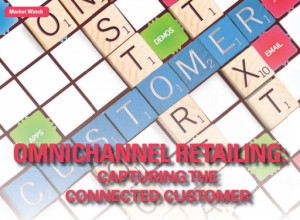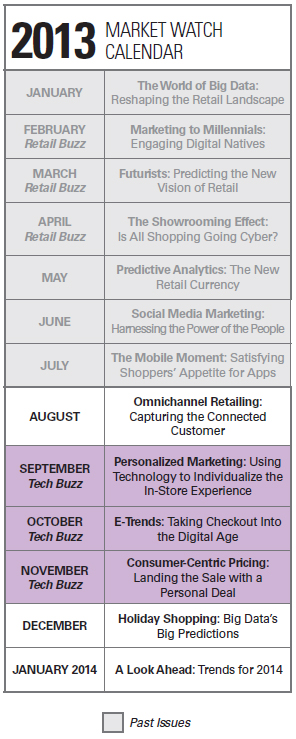 Today, shoppers armed with a dizzying array of devices and apps are demanding a more seamless retail experience—one that easily connects them to the best product, at the best price, with the best (and most convenient) point of purchase for them—whether that be in-store or online. Enter omnichannel retailing, where all communication channels are harmoniously integrated with the mission of putting the consumer in the driver’s seat and positioning retailers to be the provider of a more personalized and customized shopping experience across all channels.
Today, shoppers armed with a dizzying array of devices and apps are demanding a more seamless retail experience—one that easily connects them to the best product, at the best price, with the best (and most convenient) point of purchase for them—whether that be in-store or online. Enter omnichannel retailing, where all communication channels are harmoniously integrated with the mission of putting the consumer in the driver’s seat and positioning retailers to be the provider of a more personalized and customized shopping experience across all channels.
Omnichannel retailing ensures that no matter how you reach out to your customer (or your customer reaches out to you)—whether in-store or online, or via a mobile app or a text message, an email or a flyer—he or she will receive a single, consistent shopping experience. The same price point, discount, make or model, product or service will be advertised and available to customers whether they see it in a retailer’s outlet, on the Internet, while flipping through a store catalogue or reading about it on Facebook.
Even if you’ve never heard of omnichannel retailing, it’s worth paying attention to. Research shows that omnichannel customers spend up to 50 percent more than other shoppers, according to IDC Retail Insights. And they also tend to develop stronger brand loyalty, telling their friends and associates about it—especially through social media.
Retailers across just about every industry, from grocery to electronics to hardware, are setting the standard for omnichannel retailing. It’s common to see stores let their customers check inventory by store, buy online and pick up their product at a chosen location—or have it delivered. Some stores are even transforming their brick and mortar locations into brand showrooms where shoppers can touch and test products while looking through the store’s online catalogs and website.
For retailers, a seamless omnichannel experience begins by bringing together back-end operations for each channel of communication. It’s not enough for a retailer to be multi-channel and merely have a presence on various online sites and in person—all of those channels must communicate with each other instantaneously to provide a seamless experience. Behind the scenes, a retailer may have to take the steps necessary to ensure that its online store that has one fulfillment system and supply chain model communicates with the operations of its brick-and-mortar location. Otherwise, the retailer could create inequities among its own mediums.
The back-end processes must be merged in order to provide customers with the same discounts, pricing, product or service no matter what channel or device they are using to reach retailers and brands. In other words, when customers see a post about a new product on social media, they need to be able to simultaneously locate the exact model/flavor/size/color they want and purchase it either online or at a specific retailer location they are directed to.
Developing such capabilities requires significant investments in technology and data analysis. But these investments are worth it and are key to both retailers’ and brands’ futures. “Technology is paramount to driving growth and enhancing customer engagement for retailers,” said Mark Larson, partner and global leader of retail for advisory firm KPMG, in a recent interview with Progressive Grocer. “With consumer behavior, spending and demographic profiles changing rapidly, it is absolutely critical that companies take an omnichannel approach to engage consumers, utilizing all the platforms at their disposal.”
Just as important as getting a retailer’s back-end systems running in tandem, is getting the front-end consumer experience aligned. For example, if customers pin an item from a brand’s Pinterest board, that same product should appear front and center the next time they visit the brand’s website. Or when customers purchase a product online from a retailer, associates on its social media channels and at its nearest retail location should be able to pull up the information and help them out with the order. Customers should also immediately receive product or service recommendations via smartphone, email or text message that would complement their purchase and drive another sale. So, if shoppers buy a gas grill for their annual 4th of July celebration, offers for items such as patio furniture, beer, hamburgers, or any other related accessories or amenities they could use should pop up on all of their various communications devices simultaneously.
By using big data and predictive modeling, retailers can further personalize the omnichannel world for shoppers. For example, by gleaning information from previous purchases and buying behavior, retailers can send coupons and other promotions directly targeted to loyal consumers. And retailers can deliver them through the vehicle shoppers like best—whether it is printable coupons, discount codes delivered through social media, or mobile alerts about upcoming sales on related items.
One key component that should not be overlooked when building one’s brand through omnichannel retailing is the power of a personal connection. Shoppers should experience the same quality service from retail or brand representatives that they do via social media and vice versa. Retail associates must be able to provide a level of knowledge about products or services that meets or exceeds the information available to shoppers across a company’s digital and physical channels—all while providing top-quality customer service.
As consumers continue to become more connected, changing the way they shop and interact with retailers and brands, it is more important than ever to understand and embrace omnichannel retailing as the new industry standard, according to John Dettenwanger Jr., chief information officer for Ahold USA, in a recent interview with CIO.com. “Customers are going to define how they want to shop, and if we’re not enabling that [through omnichannel retailing], we’ll become irrelevant.”


